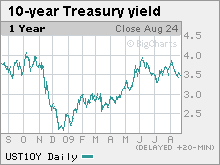Treasurys tread water
Government debt prices fluctuate within a narrow range as investors weigh better-than-expected consumer confidence and housing data and a well-bid debt sale.
NEW YORK (CNNMoney.com) -- Treasury prices bounced around breakeven on Tuesday as Wall Street climbed higher and the first of three debt auctions slated for the week was met with solid demand.
Wall Street cheered two better-than-expected reports on the economy, applauded President Obama renominating Ben Bernanke to the Federal Reserve, and absorbed new deficit estimates. And when stocks rally, investors tend to pull funds out of the safe haven of government bonds.
The Conference Board's Consumer Confidence Index rose to 54.1 in August, flying past economists' expectation of 48. Home prices increased 2.9% in the three months ended June 30, according to the latest S&P/Case-Shiller report, marking the first quarter-over-quarter improvement in three years.
President Obama ended speculation over who would head the Federal Reserve, nominating current Chairman Ben Bernanke for a second term.
"The President just confirmed his reappointment of Ben Bernanke as Fed Chairman. Good idea, Mr. President," said Kevin Giddis, the head of fixed income sales, trading and research at Morgan Keegan, in a research note. "To introduce a new variable at this point in the process would be dangerous on many fronts."
The White House now expects the 10-year budget deficit to reach $9.05 trillion, roughly $2 trillion more than it estimated earlier in the year, according to a report released by the Office of Management and Budget.
The Obama administration has been funding a multi-pronged rescue effort for the economy that has stretched from Wall Street mega-banks to the clunker in your driveway.
In the process, Uncle Sam has racked up a record-sized debt load. To raise cash to fund various government bailout programs, the Treasury has been selling its debt.
The new announcement of the decade-long deficit projection did little to move the Treasury markets. "Budget deficits usually never meet their projections over that long a period of time," said Mary Ann Hurley, vice president of fixed income trading at D.A. Davidson.
$109 billion in auctions: Just this week, the Treasury is scheduled to auction off $109 billion worth of debt. The market watches the auctions closely to take a pulse on demand - in particular from foreign buyers, a key component of the demand for Uncle Sam's debt.
On Tuesday, $42 billion of 2-year notes hit the chopping block. This was the first of three closely watched auctions to happen this week, and it had a bid-to-cover ratio of 2.68, with almost $113 billion worth of bids coming in for $42 billion worth of debt available.
Wednesday, the government is set to sell $39 billion of 5-year notes, and Thursday, Treasury will sell $28 billion of 7-year notes.
Demand for U.S. government bonds has held up relatively well during the recession because investors consider Treasurys to be one of the safest places to park cash in times of uncertainty -- because Treasurys are backed by the government, the thinking is that Uncle Sam will make good on those debts.
Yields and prices move in opposite direction so when investors seek the safe haven of Treasurys, expect to see prices rise and yields decline.
Yields on the benchmark 10-year note have been hovering around 3.4% recently but just a little more than two months ago, that yield topped 4% -- a level not seen since mid-October -- signaling underlying inflation fears.
Buyback continues: In an effort to spur demand, the government started buying back its own debt. The $300 billion so-called quantitative easing program aims to keep demand in the Treasury marketplace healthy in order to keep yields low.
Home mortgage rates move in tandem to Treasury yields. High mortgage rates discourage home buyers. The housing market caved in on itself as home prices dropped and credit markets cinched. To keep housing on the track to recovery, the government would like to keep Treasury yields - and by extension mortgage rates - low.
Monday, the government bought $6.1 billion worth of debt that expires between May 2011 and April of 2012. Wednesday, the Fed will make the next installment of its debt buyback, purchasing an undisclosed amount of debt that matures between Aug. 15, 2026, and Aug. 15, 2039.
Debt prices: The benchmark 10-year note was up 2/32 to 101-1032, and its yield was 3.47%. Bond prices and yields move in opposite directions.
The 30-year bond added 5/32 to 104-3/32, and its yield rose to 4.26%.
The 2-year note was down 1/32 to 99-3/32, and its yield edged up to 1.05%.The yield on the 3-month bill dipped to 0.16%.
Lending rates: Bank-to-bank lending hover at historically low levels, a positive indication of for once-frozen pipelines of credit.
The three-month Libor ticked very slightly lower to 0.38%, according to Bloomberg.com. The overnight Libor rate was also nearly unchanged at 0.23%.
The London Interbank Offered Rate -- or Libor -- is a daily average of rates that 16 different banks charge each other to lend money. The closely watched benchmark is used to calculate adjustable-rate mortgages. More than $350 trillion in assets are tied to Libor. ![]()


